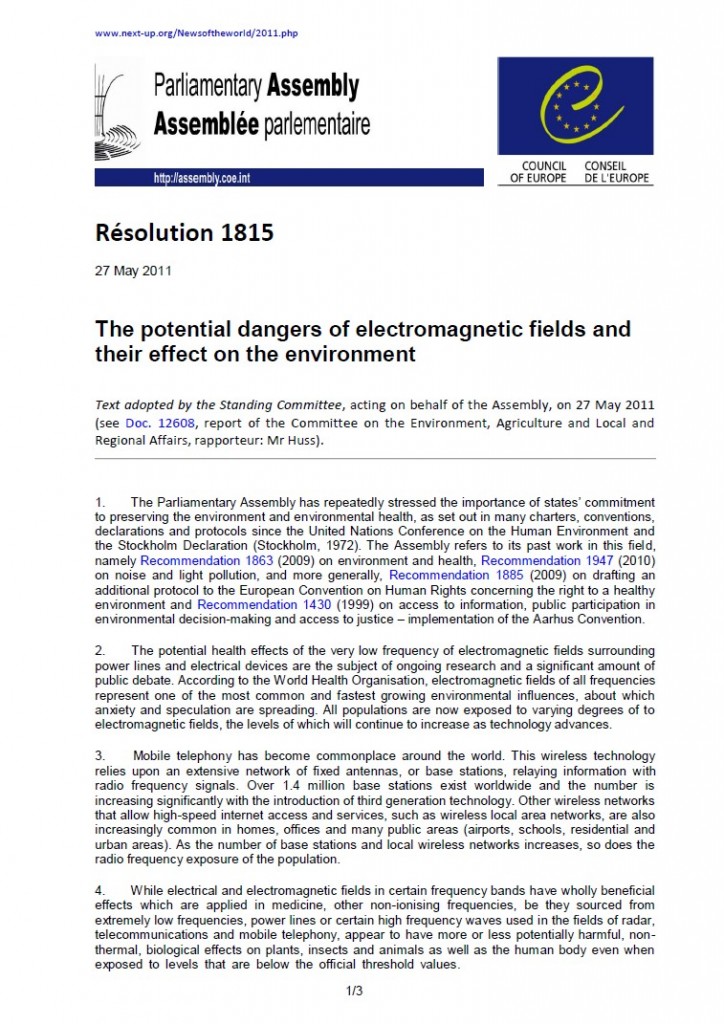Portada del sitio > Estudios Científicos > Evidence for a health risk by RF on humans living around mobile phone base (...)

Evidence for a health risk by RF on humans living around mobile phone base stations: From radiofrequency sickness to cancer
Miércoles 30 de noviembre de 2022 · 524 lecturas
Evidence for a health risk by RF on humans living around mobile phone base stations: From radiofrequency sickness to cancer
Author A.Balmori
https://www.sciencedirect.com/science/article/abs/pii/S0013935122011781?via%3Dihub
Abstract
The objective of this work was to perform a complete review of the existing scientific literature to update the knowledge on the effects of base station antennas on humans. Studies performed in real urban conditions, with mobile phone base stations situated close to apartments, were selected. Overall results of this review show three types of effects by base station antennas on the health of people: radiofrequency sickness (RS), cancer (C) and changes in biochemical parameters (CBP). Considering all the studies reviewed globally (n = 38), 73.6% (28/38) showed effects: 73.9% (17/23) for radiofrequency sickness, 76.9% (10/13) for cancer and 75.0% (6/8) for changes in biochemical parameters. Furthermore, studies that did not meet the strict conditions to be included in this review provided important supplementary evidence. The existence of similar effects from studies by different sources (but with RF of similar characteristics), such as radar, radio and television antennas, wireless smart meters and laboratory studies, reinforce the conclusions of this review. Of special importance are the studies performed on animals or trees near base station antennas that cannot be aware of their proximity and to which psychosomatic effects can never be attributed.
Introduction
During the last few decades, hundreds of thousands of mobile phone base stations and other types of wireless communications antennas have been installed around the world, in cities and in nature, including protected natural areas, in addition to pre-existing antennas (television, radio broadcasting, radar, etc.). Only the aesthetic aspects or urban regulations have been generally considered in this deployment, while the biological, environmental and health impacts of the associated non-ionizing electromagnetic radiation emissions have not been assessed so far. Therefore, the effects on humans living around these anthropogenic electromagnetic field sources (antennas) have not been considered.
In France, there is a significant contribution of mobile phone base stations in the exposure to radiofrequency electromagnetic fields (RF-EMF) of urban citizens living nearby (De Giudici et al., 2021). Some studies from India indicate that more than 15% of people have levels of EMF strength above 12 V/m due to their proximity to antennas (Premlal and Eldhose, 2017). Exposure estimates have shown that RF-EMF from mobile telephone systems is stronger in urban than in rural areas. For instance, in Sweden the levels of RF radiation have increased considerably in recent years, both outdoor and indoor, due to new telecommunication technologies, and the median power density measured for RF fields between 30 MHz and 3 GHz was 16 μW/m2 in rural areas, 270 μW/m2 in urban areas and 2400 μW/m2 in city areas (Hardell et al., 2018). Total exposure varies not only between urban and rural areas but also, depending on residential characteristics, between different floors of a building, with a tendency for building exposure to increase at higher floors (Breckenkamp et al., 2012).
Over the past five decades, and more intensively since the beginning of this century, many studies and several reviews have been published on the effects of anthropogenic electromagnetic radiation on humans living around the antennas. The first studies were carried out with radio and television antennas, investigating increases in cancer and leukaemia (Milham, 1988; Maskarinec et al., 1994; Hocking et al., 1996; Dolk et al., 1997a, 1997b; Michelozzi et al., 1998; Altpeter et al., 2000), as well as around radars (Kolodynski and Kolodynska, 1996; Goldsmith, 1997).
Regarding base station antennas, there are scientific discrepancies in their effects: some studies concluded that there are no health-related effects (e.g. Augner and Hacker, 2009; Blettner et al., 2009; Röösli et al., 2010; Baliatsas et al., 2016) whereas others found increases in cancer and other health problems in humans living around antennas (e.g. Santini et al., 2002; Navarro et al., 2003; Bortkiewicz et al., 2004; Eger et al., 2004; Wolf and Wolf, 2004; Abdel-Rassoul et al., 2007; Khurana et al., 2010; Dode et al., 2011; Shinjyo and Shinjyo, 2014; Gandhi et al., 2015; López et al., 2021; Rodrigues et al., 2021). There is a specific symptomatology linked to radar and RF exposure at low levels, characterized by functional disturbances of the central nervous system (headache, sleep disturbance, discomfort, irritability, depression, memory loss, dizziness, fatigue, nausea, appetite loss, difficulty in concentration, dizziness, etc.), that has been termed ‘RF sickness’ (Lilienfeld et al., 1978; Johnson Lyakouris, 1998; Navarro et al., 2003).
The objective of this study was to perform a complete review of the existing scientific literature to update the knowledge on the effects of base stations on humans living around the antennas.
Section snippets
Methods
A search was performed in the EMF portal, Google Scholar and PubMed databases with the words: “mobile phone base station and health” or “cell tower and health”.
Only studies performed in real urban conditions, with mobile phone base stations situated close to apartments, were selected. Studies conducted in larger regions with numerous antennas, based on surveys and geographic data, were also included.
On the contrary, studies were excluded that considered different sources of electromagnetic
Results
The studies that met the selected criteria are presented in chronological order in Table 1, catalogued as Y/N depending on whether or not they found effects. The selected studies cover three types of effects: radiofrequency sickness (RS) (according to Lilienfeld et al., 1978; Johnson Lyakouris, 1998), cancer (C) and changes in biochemical parameters (CBP). Table 1 also includes the authors, year and country, antenna type, study design, diseases and symptoms found/not found and the main
Discussion
The results of this review show three types of effects by base station antennas on the health of humans: radiofrequency sickness, cancer and changes in biochemical parameters (Fig. 1). From among all these studies, most of them found effects (73.6%). Thus, despite some limitations and differences in study design, statistical measures, risk estimates and exposure categories (Khurana et al., 2010), together they provide a consistent view of the effects on the health of people living in the
The Precautionary Principle
The International Commission on Non-Ionizing Radiation Protection (ICNIRP) is a private organization that issues exposure guidelines that are then adopted by governments, but it has been accused of having conflicts of interest (Hardell and Carlberg, 2020; Hardell et al., 2021). The ICNIRP (2010, 2020) limits are thousands of times above the levels where effects are recorded for both extremely low frequency and RF man-made EMF and account only for thermal effects, whereas the vast majority of
Conclusion
In the current circumstances, it seems that the scientific experts in the field are very clear about the serious problems we are facing and have expressed this through important appeals (Blank et al., 2015; Hardell and Nyberg, 2020). However, the media, the responsible organizations (World Health Organization, 2015) and the governments are not transmitting this crucial information to the population, who remain uninformed. For these reasons, the current situation will probably end in a crisis
Declaration of competing interest
The authors declare that they have no known competing financial interests or personal relationships that could have appeared to influence the work reported in this paper.
References (164)
M. Kundi et al.
Mobile phone base stations—effects on wellbeing and health
Pathophysiology
(2009)
R.N. Kostoff et al.
Adverse health effects of 5G mobile networking technology under real-life conditions
Toxicol. Lett.
(2020)
A.A. Kolodynski et al.
Motor and psychological functions of school children living in the area of the Skrunda Radio Location Station in Latvia
Sci. Total Environ.
(1996)
A. Klaps et al.
Mobile phone base stations and well-being—a meta-analysis
Sci. Total Environ.
(2016)
E.G. Kıvrak et al.
Effects of electromagnetic fields exposure on the antioxidant defense system
J. Micros. Ultrastruct.
(2017)
S. Islam et al.
Awareness and self-reported health hazards of electromagnetic waves from mobile phone towers in Dhaka, Bangladesh: a pilot study
Adv. Pub. Health
(2014)
P. Frei et al.
Cohort study on the effects of everyday life radio frequency electromagnetic field exposure on non-specific symptoms and tinnitus
Environ. Int.
(2012)
L. Falcioni et al.
Report of final results regarding brain and heart tumors in Sprague-Dawley rats exposed from prenatal life until natural death to mobile phone radiofrequency field representative of a 1.8 GHz GSM base station environmental emission
Environ. Res.
(2018)
E.F. Eskander et al.
How does long term exposure to base stations and mobile phones affect human hormone profiles?
Clin. Biochem.
(2012)
A.C. Dode et al.
moreira CW, condessa VA, albinatti C, and caiaffa WT. Mortality by neoplasia and cellular telephone base stations in the belo horizonte municipality, minas gerais state, Brazil
Sci. Total Environ.
(2011)
P. De Giudici et al.
Radiofrequency exposure of people living near mobile-phone base stations in France
Environ. Res.
(2021)
S. Cucurachi et al.
A review of the ecological effects of radiofrequency electromagnetic fields (RF-EMF)
Environ. Int.
(2013)
D.O. Carpenter
Extremely low frequency electromagnetic fields and cancer: how source of funding affects results
Environ. Res.
(2019)
P. Boscolo et al.
Effects of electromagnetic fields produced by radiotelevision broadcasting stations on the immune system of women
Sci. Total Environ.
(2001)
D. Belpomme et al.
Why Electrohypersensitivity and Related Symptoms Are Caused by Non-ionizing Man-Made Electromagnetic Fields: an Overview and Medical Assessment
(2022)
J. Beekhuizen et al.
Geospatial modelling of electromagnetic fields from mobile phone base stations
Sci. Total Environ.
(2013)
P. Bandara et al.
Planetary electromagnetic pollution: it is time to assess its impact
Lancet Planet. Health
(2018)
C. Baliatsas et al.
Clinically defined non-specific symptoms in the vicinity of mobile phone base stations: a retrospective before-after study
Sci. Total Environ.
(2016)
C. Augner et al.
Effects of exposure to GSM mobile phone base station signals on salivary cortisol, alpha-amylase, and immunoglobulin A
Biomed. Environ. Sci.
(2010)
I. Atzmon et al.
Cancer risks in the druze isifya village: reasons and RF/MW antennas
Pathophysiology
(2012)
O.F. Al-Quzwini et al.
Male fertility and its association with occupational and mobile phone towers hazards: an analytic study
Middle East Fertil. Soc. J.
(2016)
G. Abdel-Rassoul et al.
Neurobehavioral effects among inhabitants around mobile phone base stations
Neurotoxicology
(2007)
T. Abelin et al.
Sleep disturbances in the vicinity of the short-wave broadcast transmitter Schwarzenburg
Somnologie-Schlafforschung und Schlafmedizin
(2005)
Y. Akkam et al.
Correlation of blood oxidative stress parameters to indoor radiofrequency radiation: a cross sectional study in Jordan
Int. J. Environ. Res. Publ. Health
(2020)
S.A. Alazawi
Mobile phone base stations health effects
Diyala J. Med.
(2011)
Z.O. Alhekail et al.
Public safety assessment of electromagnetic radiation exposure from mobile base stations
J. Radiol. Prot.
(2012)
E. Altpeter et al.
Ten years experience with epidemiological research in the vicinity of the short-wave broadcasting area Schwarzenburg: what does the story tell us
E.S. Altpeter et al.
Effect of short‐wave (6–22 MHz) magnetic fields on sleep quality and melatonin cycle in humans: the Schwarzenburg shut‐down study
Bioelectromagnetics
(2006)
H.K. Admawi
Assessment of electromagnetic pollution in some hospitals and schools in Al-najaf city
J. Eng.
(2021)
M.T. Ali et al.
Evaluation study of radio frequency radiation effects from cell phone towers on human health
Radioelectron. Commun. Syst.
(2021)
E. Altpeter et al.
Ten years experience with epidemiological research in the vicinity of the short-wave broadcasting area Schwarzenburg: what does the story tell us
H. Aniołczyk
Electromagnetic field pattern in the environment of GSM base stations
Int. J. Occup. Med. Environ. Health
(1999)
C. Augner et al.
Are people living next to mobile phone base stations more strained? Relationship of health concerns, self-estimated distance to base station, and psychological parameters
Indian J. Occup. Environ. Med.
(2009)
C. Augner et al.
GSM base stations: short‐term effects on well‐being
Bioelectromagnetics
(2009)
M. Azimzadeh et al.
Alteration of testicular regulatory and functional molecules following long‐time exposure to 900 MHz RFW emitted from BTS
Andrologia
(2019)
C. Baliatsas et al.
Non-specific physical symptoms in relation to actual and perceived proximity to mobile phone base stations and powerlines
BMC Publ. Health
(2011)
A. Balmori
Possible effects of electromagnetic fields from phone masts on a population of white stork (Ciconia ciconia)
Electromagn. Biol. Med.
(2005)
A. Balmori et al.
The urban decline of the house sparrow (Passer domesticus): a possible link with electromagnetic radiation
Electromagn. Biol. Med.
(2007)
A. Balmori
Mobile phone mast effects on common frog (Rana temporaria) tadpoles: the city turned into a laboratory
Electromagn. Biol. Med.
(2010)
G. Berg-Beckhoff et al.
Mobile phone base stations and adverse health effects: phase 2 of a cross-sectional study with measured radio frequency electromagnetic fields
Occup. Environ. Med.
(2009)
J.F. Bithell
Childhood cancer and proximity to mobile phone masts
Bmj
(2010)
M. Blank et al.
International Appeal: scientists call for protection from non-ionizing electromagnetic field exposure
Eur. J. Oncol.
(2015)
M. Blettner et al.
Mobile phone base stations and adverse health effects: phase 1 of a population-based, cross-sectional study in Germany
Occup. Environ. Med.
(2009)
C. Boehmert et al.
A systematic review of health risk communication about EMFs from wireless technologies
J. Risk Res.
(2020)
A. Bortkiewicz et al.
Subjective symptoms reported by people living in the vicinity of cellular phone base stations: review
Med. Pr.
(2004)
J. Breckenkamp et al.
Residential characteristics and radiofrequency electromagnetic field exposures from bedroom measurements in Germany
Radiat. Environ. Biophys.
(2012)
A. Bürgi et al.
Exposure modeling of high-frequency electromagnetic fields
J. Expo. Sci. Environ. Epidemiol.
(2008)
A. Bürgi et al.
Time averaged transmitter power and exposure to electromagnetic fields from mobile phone base stations
Int. J. Environ. Res. Publ. Health
(2014)
H.Y. Chen et al.
Currents induced in human bodies during radiofrequency exposure near a cellular phone base station
Electromagnetics
(2009)
D. Coggon
Health risks from mobile phone base stations
Occup. Environ. Med.
(2006)
There are more references available in the full text version of this article.







